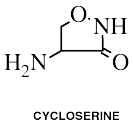

Cycloserine
Brand Names: SeromycinPlease read the disclaimer concerning the intent
and limitations of the information provided here.
The information presented in Interactions is for
informational and educational purposes only. It is based on scientific
studies (human, animal, or in vitro), clinical experience, case
reports, and/or traditional usage with sources as cited in each
topic. The results reported may not necessarily occur in all
individuals and different individuals with the same medical conditions
with the same symptoms will often require differing treatments. For
many of the conditions discussed, treatment with conventional medical
therapies, including prescription drugs or over-the-counter
medications, is also available. Consult your physician, an
appropriately trained healthcare practitioner, and/or pharmacist for
any health concern or medical problem before using any herbal products
or nutritional supplements or before making any changes in prescribed
medications and/or before attempting to independently treat a medical
condition using supplements, herbs, remedies, or other forms of
self-care.
![]()
Do not rely solely on the information in this article.
References
Goldshtein VD, Fondaminskaia LD, Semenova AS. [The influence of cycloserine on the metabolism of several B complex vitamins in pulmonary tuberculosis].
Probl Tuberk 1971;49(11):15-19. [Article in Russian]
Haden HT. Pyridoxine-responsive sideroblastic anemia due to antituberculous drugs.
Arch Intern Med 1967 Nov;120(5):602-606.
Laine-Cessac P, Cailleux A, Allain P. Mechanisms of the inhibition of human erythrocyte pyridoxal kinase by drugs.
Biochem Pharmacol 1997 Oct 15;54(8):863-870.
Abstract: The aim of this study was to investigate the interaction between drugs chosen for their clinical neurotoxicity or chemical structure and vitamin B6 metabolism. After a preliminary screening of drugs to determine their potential inhibitory effect on erythrocyte nonpurified pyridoxal kinase (PLK) (EC 2.7.1.35), additional investigations, including kinetic studies and detection of chemical reactivity between the inhibiting drugs and pyridoxal (PL) or pyridoxal-5'-phosphate (PLP), using UV-visible spectrophotometry and mass analysis, were carried out to specify the mechanism of PLK inhibition. Depending on the results, the inhibiting drugs were divided into three groups. The first group included theophylline and progabide and inhibited PLK using either PL or pyridoxamine (PM) as substrate and thereby were true inhibitors. Moreover, they did not form covalent complexes with PL or PLP. The second group, which included cycloserine, dopamine, isoniazid, and thiamphenicol glycinate, inhibited PLK using PL, but not PM, as substrate. They were able to react with PL or PLP to form covalent complexes, and kinetic studies suggested that the observed PLK inhibition was due to these formed complexes. A third group, which consisted of levodopa, D-penicillamine, and muzolimine, inhibited PLK using PL, but not PM, as substrate. They formed, with PL or PLP, chemical derivatives that probably had no inhibitory effect on PLK. These results and the clinical consequences of such interactions are discussed and compared with results of previous studies.
Nair S, Maguire W, Baron H, Imbruce R. The effect of cycloserine on pyridoxine-dependent metabolism in tuberculosis.
J Clin Pharmacol 1976 Aug;16(8-9):439-443.
Abstract: Measurements were made of urinary tryptophan metabolites of 13 tuberculosis patients in order to reveal characteristics of pyridoxine-dependent metabolism before and during cycloserine treatment. The abnormally high level of xanthurenic acid excretion in untreated patients suggests a decreased availability of pyridoxal phosphate related to the disease process. Although plasma cycloserine levels were kept high once therapy began, xanthurenic acid excretion before and after tryptophan load became progressively more normal as symptoms diminished. This observation suggests that the convulsions which may sometimes accompany cycloserine administration are not due to a direct pyridoxine antagonism by the drug. Throughout the study, no significant changes in 5-hydroxyindoleacetic acid excretion were observed. Presumably, the metabolic pathway of serotonin is unaffected by tryptophan loading, cycloserine administration, or the apparent pyridoxine depletion associated with tuberculosis.
Roe D. Risk factors in drug-induced nutritional deficiencies. In: Roe D, Campbell T, eds.
Drugs and Nutrients: The Interactive Effects. New York: Marcel Decker, 1984, 288-289, 505-523.